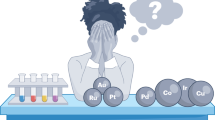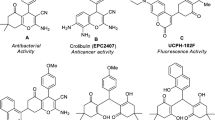Abstract
Homogeneous catalysts—which exist in the same (usually liquid) phase as reactants and products—are usually more selective than heterogeneous catalysts and far less affected by limitations due to slow transport of reactants and products, but their separation from reaction products can be costly and inefficient. This has stimulated the development of strategies that facilitate the recycling of homogeneous catalysts1,2,3,4. Some of these methods exploit the preference of a catalyst for one of two solvents with thermoregulated miscibility5,6; others exploit a dramatic decrease in catalyst solubility as one reagent is consumed7,8 or temperature changed after completion of the reaction9,10,11,12,13,14. Here we describe a tungsten catalyst for the solvent-free hydrosilylation of ketones that retains its activity until essentially all of the liquid substrate is converted to liquid products, which we can then simply decant to separate the catalyst that precipitates from the products of the reaction. We attribute the ability of the catalyst to retain its solubility and hence activity until completion of the reaction to the transient formation of liquid clathrate15,16 that contains a few molecules of the substrate per molecule of the otherwise solid catalyst. Insights into the fundamental processes controlling the formation of this liquid clathrate might help to tailor other catalysts and substrates, so as to develop efficient and solvent-free schemes for reactions of practical interest.
This is a preview of subscription content, access via your institution
Access options
Subscribe to this journal
Receive 51 print issues and online access
$199.00 per year
only $3.90 per issue
Buy this article
- Purchase on Springer Link
- Instant access to full article PDF
Prices may be subject to local taxes which are calculated during checkout


Similar content being viewed by others
References
Gladysz, J. A. Introduction: Recoverable catalysts and reagents–perspective and prospective. Chem. Rev. 102, 3215–3216 (2002)
Gladysz, J. A. Recoverable catalysts. Ultimate goals, criteria of evaluation, and the green chemistry interface. Pure Appl. Chem. 73, 1319–1324 (2001)
Cole-Hamilton, D. J. Homogeneous catalysis — new approaches to catalyst separation, recovery, and recycling. Science 299, 1702–1706 (2003)
Kragl, U. & Dwars, T. The development of new methods for the recycling of chiral catalysts. Trends Biotechnol. 19, 442–449 (2001)
Horváth, I. T. Fluorous biphase chemistry. Acc. Chem. Res. 31, 641–650 (1998)
Gladysz, J. A. & Curran, D. P. Fluorous chemistry: From biphasic catalysis to a parallel chemical universe and beyond. Tetrahedron 58, 3823–3825 (2002)
Zuwei, X., Ning, Z., Yu, S. & Li, K. Reaction-controlled phase-transfer catalysis for propylene epoxidation to propylene oxide. Science 292, 1139–1141 (2001)
Hourdin, G., Germain, A., Moreau, C. & Fajula, F. The catalysis of the Ruff oxidative degradation of aldonic acids by copper(II)-containing solids. J. Catal. 209, 217–224 (2002)
Wang, Y., Jiang, J., Zhang, R., Liu, X. & Jin, Z. Thermoregulated phase transfer ligands and catalysis IX. Hydroformylation of higher olefins in organic monophase catalytic system based on the concept of critical solution temperature of the nonionic tensioactive phosphine ligand. J. Mol. Catal. A 157, 111–115 (2000)
Wende, M., Meier, R. & Gladysz, J. A. Fluorous catalysis without fluorous solvents. J. Am. Chem. Soc. 123, 11490–11491 (2001)
Wende, M. & Gladysz, J. A. Fluorous catalysis under homogeneous conditions without fluorous solvents: A “greener” catalyst recycling protocol based upon temperature-dependent solubilities and liquid/solid phase separation. J. Am. Chem. Soc. 125, 5861–5872 (2003)
Ishihara, K., Kondo, S. & Yamamoto, H . 3,5-Bis(perfluorodecyl)phenylboronic acid as an easily recyclable direct amide condensation catalyst. Synlett 1371–1374 (2001)
Ishihara, K., Hasegawa, A. & Yamamoto, H. A fluorous super Bronsted acid catalyst: Application to fluorous catalysis without fluorous solvents. Synlett 1299–1301 (2002)
Xiang, J. N., Orita, A. & Otera, J. Fluoroalkyldistannoxane catalysts for transesterification in fluorous biphase technology. Adv. Synth. Catal. 344, 84–90 (2002)
Atwood, J. L. in Coordination Chemistry of Aluminum (ed. Robinson, G. H.) 197–232 (VCH, New York, 1993)
Steed, J. W. & Atwood, J. L. Supramolecular Chemistry 707 (Wiley, Chichester, 2002)
Anastas, P. T. & Kirchhoff, M. M. Origins, current status, and future challenges of green chemistry. Acc. Chem. Res. 35, 686–694 (2002)
Anastas, P. T. & Zimmerman, J. B. Design through the 12 principles of green engineering. Environ. Sci. Technol. 37, 94A–101A (2003)
DeSimone, J. M. Practical approaches to green solvents. Science 297, 799–803 (2002)
Holbrey, J. D. et al. Liquid clathrate formation in ionic liquid–aromatic mixtures. Chem. Commun. 476–477 (2003)
Lambert, J. B., Zhao, Y., Wu, H., Tse, W. C. & Kuhlmann, B. The allyl leaving group approach to tricoordinate silyl, germyl, and stannyl cations. J. Am. Chem. Soc. 121, 5001–5008 (1999)
Korolev, A. V., Ihara, E., Young, V. G. Jr & Jordan, R. F. Cationic aluminum alkyl complexes incorporating aminotroponiminate ligands. J. Am. Chem. Soc. 123, 8291–8309 (2001)
Borovik, A. S. & Barron, A. R. Arene-mercury complexes stabilized by aluminum and gallium chloride: Catalysts for H/D exchange of aromatic compounds. J. Am. Chem. Soc. 124, 3743–3748 (2002)
Ojima, I. in The Chemistry of Organic Silicon Compounds (eds Patai, S. & Rappoport, Z.) 1479–1526 (Wiley, New York, 1989)
Ojima, I., Li, Z. & Zhu, J. in The Chemistry of Organic Silicon Compounds, Vol. 2 (eds Rappoport, Z. & Apeloig, Y.) 1687–1792 (Wiley, New York, 1998)
Dioumaev, V. K., Szalda, D. J., Hanson, J., Franz, J. A. & Bullock, R. M. An N-heterocyclic carbene as a bidentate hemilabile ligand: A synchrotron X-ray diffraction and density functional theory study. Chem. Commun. 1670–1671 (2003)
Bullock, R. M. & Voges, M. H. Homogeneous catalysis with inexpensive metals: Ionic hydrogenation of ketones with molybdenum and tungsten catalysts. J. Am. Chem. Soc. 122, 12594–12595 (2000)
Voges, M. H. & Bullock, R. M. Catalytic ionic hydrogenations of ketones using molybdenum and tungsten complexes. J. Chem. Soc. Dalton Trans. 759–770 (2002)
Acknowledgements
This research was supported by the Division of Chemical Sciences, Office of Basic Energy Sciences, of the US Department of Energy.
Author information
Authors and Affiliations
Corresponding author
Ethics declarations
Competing interests
The authors declare that they have no competing financial interests.
Supplementary information
Rights and permissions
About this article
Cite this article
Dioumaev, V., Bullock, R. A recyclable catalyst that precipitates at the end of the reaction. Nature 424, 530–532 (2003). https://doi.org/10.1038/nature01856
Received:
Accepted:
Issue Date:
DOI: https://doi.org/10.1038/nature01856
This article is cited by
-
Challenges and outlook for catalytic direct amidation reactions
Nature Catalysis (2019)
-
Benzylation with Benzyl Alcohol Catalyzed By [ChCl][TfOH]2, a Brønsted Acidic DES with Reaction Control Self-Separation Performance
Catalysis Letters (2018)
-
Selenium catalyzed Fe(III)-EDTA reduction by Na2SO3: a reaction-controlled phase transfer catalysis
Environmental Science and Pollution Research (2016)
-
Star-like polyionic heterogeneous nanocatalyst as a highly active catalyst for promotion of Baylis–Hillman reaction in [bmim]Cl
Journal of the Iranian Chemical Society (2015)
-
Transesterification Catalyzed by Superhydrophobic–Oleophilic Mesoporous Polymeric Solid Acids: An Efficient Route for Production of Biodiesel
Catalysis Letters (2013)
Comments
By submitting a comment you agree to abide by our Terms and Community Guidelines. If you find something abusive or that does not comply with our terms or guidelines please flag it as inappropriate.



